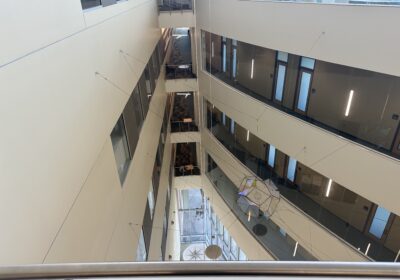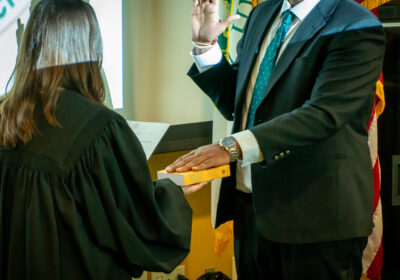St. Pete’s University Student Center to undergo renovations in 2023

Renovations to the first floor of the University Student Center (USC) at the St. Pete campus are in the early stages of development, including plans to repurpose the space to provide more lounge nooks, seating areas and new entrances for students.
Currently, the USC is mostly dedicated to dining services for students as it is home to The Reef dining hall. However, with the recent opening of the newest dining hall, The Nest, in spring on the first floor of Osprey Suites, Director of Resource Management for Student Success Anthony Carinci said a change was now possible and necessary to repurpose the space in the USC.
“Now we’ve built a purposeful and intentional dining hall in [Osprey Suites], the student center gets a chance to rethink the purpose of the whole building since we originally had to dedicate so much space and operational resources to it being the only [main] dining facility,” he said.
Construction isn’t likely to start until summer 2023, but when it begins, Carinci said the team hopes to transform the USC from a dining-specific area to one that resembles the Marshall Student Center (MSC) at the Tampa campus.
“This is an opportunity for us to reinvent what the student center can be on our campus,” Carinci said. “[At the MSC] there’s a lot of lounge spaces, flexible seating, places to study, study rooms, a gallery and more. There’s all these kinds of spaces to add to the student experience that we haven’t had the luxury of having because we had to be the only main dining facility before [the new one opened].”
Other priorities and structural changes happening at the USC include adding new entrances in order to improve accessibility for students
“One of the priorities of the project is to create a primary entrance on the north side of the building so when students are coming from Osprey Suites to the main heart of campus, they have an entry into the student center on the side that they’re walking on,” he said.
“What that allows us to do is on the west side of the building, which is currently the main entrance, we can now make that more of a dining-focused entrance. It’ll allow us to have dedicated entrances.”
Carinci said another priority on the list includes the addition of a dedicated housing entrance, as students currently have to walk through the USC to get to the housing building.
While no plans have been confirmed for how the space will be utilized, Carinci said many other ideas are currently in discussion, and both past and future student surveys will allow them to understand what students want to see in the USC.
Ideas aren’t just revolving around structural changes, according to Carinci. He said student feedback has allowed Student Success to begin to consider projects such as an esports space and a playhouse-style theater.
Changes to the dining service located in the USC are also underway, as Carinci said Aramark, USF’s food service provider, has given a significant amount of support to the project.
“[Aramark] plans to devote some money to repurposing [the dining space] in the student center,” he said. “So a big reason that this project is moving forward is that we’re changing the student center from being basically the dining room of campus to being more of like what you would experience in a living room of campus.”
Plans for the dining space are currently unknown, but Carinci said Aramark is taking the time to understand what concepts, such as new menu items, would fit with the renovated USC when it opens.
“We wanted to do [the changes] in conjunction with the changes that Aramark was going to make because we wanted to feel holistic and to be able to do that in harmony with them to create just a better space overall,” Carinci said.
Permission to go ahead with the project was granted and voted on by the Capital Improvement Trust Fund Committee (CITFC) in 2019. The renovations are second on the priority list of projects CITFC approved, which explains why construction won’t start until 2023, according to Carinci.
The proposed project budget is about $2 million, of which approximately $1.3 million will come from the CITFC allocation, according to Carinci. The campus receives a little over $600,000 per year from the CITFC allocation, so Carinci said the university will collect those funds in 2021-22, which adds up to the $1.3 million.
“The rest of [the funds] will come from the reserves of the student center. There is an A&S that’s dedicated to the operations of the student center, and that fee hasn’t fully been expended each year. There’s been a reserve that’s been able to compile over the course of time, so we have over a million dollars in that reserve and can dedicate about $700,000 or more if needed to the project.”
Carinci said any food service renovations will be made with funds provided by Aramark.
Student feedback is essential in completing the project, according to Carinci, and he encourages students to make their voices heard on any ideas for the upcoming renovations.
“We’re still in the ideation phase, so there’s nothing that’s been decided. If there’s any students that want to get involved with the project and to talk more about it, I would really encourage them to come to the University Student Center information desk and say hi, or even email or call us to get in touch with us and lend their voice,” he said.
“At the end of the day, this will be driven by student voices and by the voices of the St. Petersburg community. It’s a cool opportunity to sort of leave your legacy if there’s something you’re really passionate about.”







